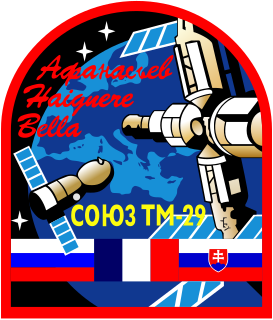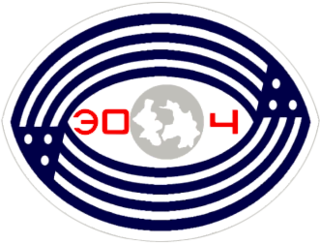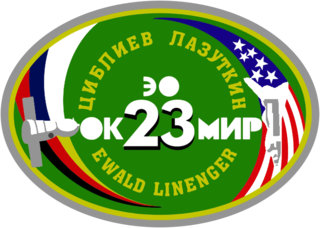
Mir was a space station that operated in low Earth orbit from 1986 to 2001, operated by the Soviet Union and later by Russia. Mir was the first modular space station and was assembled in orbit from 1986 to 1996. It had a greater mass than any previous spacecraft. At the time it was the largest artificial satellite in orbit, succeeded by the International Space Station (ISS) after Mir's orbit decayed. The station served as a microgravity research laboratory in which crews conducted experiments in biology, human biology, physics, astronomy, meteorology, and spacecraft systems with a goal of developing technologies required for permanent occupation of space.

Anatoly Yakovlevich Solovyev is a retired Russian and Soviet cosmonaut and pilot. Solovyev was born on January 16, 1948, in Riga, Latvia. Solovyev holds the world record on the number of spacewalks performed (16), and accumulated time spent spacewalking.

Gennadi Mikhailovich Strekalov, 26 October 1940 – 25 December 2004, was an engineer, cosmonaut, and administrator at Russian aerospace firm RSC Energia. He flew into space five times and lived aboard the Salyut 6, Salyut 7, and Mir space stations, spending over 268 days in space. The catastrophic explosion of a Soyuz rocket in 1983 led to him being one of only four people to use a launch escape system. He was decorated twice as Hero of the Soviet Union.

Soyuz TM-2 was the spacecraft used to launch a long duration crew to the Soviet space station Mir, which was uncrewed at the time. TM-2 was launched in February 1987, and it was first crewed spaceflight of the Soyuz-TM spacecraft, and the second crewed spaceflight to Mir. The crew of the long duration expedition, Mir EO-2, who were launched by TM-2 consisted of Soviet cosmonauts Yuri Romanenko and Aleksandr Laveykin.

Soyuz TM-3 was the third crewed spacecraft to visit the Soviet space station Mir, following Soyuz-T15 and Soyuz-TM2. It was launched in July 1987, during the long duration expedition Mir EO-2, and acted as a lifeboat for the second segment of that expedition. There were three people aboard the spacecraft at launch, including the two man crew of the week-long mission Mir EP-1, consisting of Soviet cosmonaut Aleksandr Viktorenko and Syrian Muhammed Faris. Faris was the first Syrian to travel to space, and as of November 2010, the only one. The third cosmonaut launched was Aleksandr Aleksandrov, who would replace one of the long duration crew members Aleksandr Laveykin of Mir EO-2. Laveykin had been diagnosed by ground-based doctors to have minor heart problems, so he returned to Earth with the EP-1 crew in Soyuz TM-2.

Soyuz TM-4 was the fourth crewed spacecraft to dock with the space station Mir. It was launched in December 1987, and carried the first two crew members of the third long duration expedition, Mir EO-3. These crew members, Vladimir Titov and Musa Manarov, would stay in space for just under 366 days, setting a new spaceflight record. The third astronaut launched by Soyuz TM-4 was Anatoli Levchenko, who returned to Earth about a week later with the remaining crew of Mir EO-2. Levchenko was a prospective pilot for the Soviet Space shuttle Buran. The purpose of his mission, named Mir LII-1, was to familiarize him with spaceflight.

Soyuz TM-5 was the fifth cosmonaut-carrying spacecraft to visit the Russian Space Station Mir. It was launched on June 7, 1988, carrying the Mir EP-2 mission's three-person crew. This week-long stay on Mir occurred during the third long-duration Mir expedition, Mir EO-3. The crew of EP-2 returned to Earth aboard Soyuz TM-4, while the TM-5 spacecraft remained docked to Mir, acting as the lifeboat for the long-duration crew. On September 7, 1988, the TM-5 spacecraft undocked from Mir, and landed Mir EP-3 mission's two-person visiting crew. The de-orbit procedures for Soyuz were revised after this flight, as multiple issues almost prevented the descent module's safe de-orbit and landing.

Soyuz TM-6 was the sixth crewed spacecraft to visit the Soviet Space Station Mir. It was launched in August 1988, during the station's third long-duration expedition, Mir EO-3. The three-person crew that was launched consisted of Research Doctor Valeri Polyakov, who became part of the EO-3 crew, as well as the two crew members of the week-long mission Mir EP-3, which included the first ever Afghan cosmonaut, Abdul Ahad Mohmand.

Soyuz TM-7 was the seventh crewed spacecraft to dock with the Soviet Space Station Mir. Its launch in November 1988 represented the start of the fourth long duration expedition, Mir EO-4, as it carried two more Soviet cosmonauts, Sergei Krikalev and Alexander Volkov, to the station. They would join the third crew member of EO-4, cosmonaut/physician Valeri Polyakov, who was on Mir for the second half of EO-3. Also launched by Soyuz TM-7 was French astronaut Jean-Loup Chrétien, who would take part in the 24-day French mission known as Mir Aragatz. The spacecraft Soyuz TM-7 remained docked to Mir for the duration of EO-4. At the end of EO-4 in April 1989, due to delays in the launch schedule, Mir was left uncrewed, and all three EO-4 crew members were transported back to Earth.

Soyuz TM-8 was a spacecraft used to launch and land the crew of the fifth long duration crew to the Soviet Space Station Mir. It was part of the Soyuz-TM series of spacecraft, which were the fourth generation of the Soviet Soyuz. Soyuz TM-8 was the eighth crewed spaceflight to Mir, and spent 166 days in orbit.

Soyuz TM-21 was a Soyuz mission, a human spaceflight mission transporting personnel to the Russian space station Mir. Part of the US/Russian Shuttle-Mir Program, the mission launched from Baikonur Cosmodrome, atop a Soyuz-U2 carrier rocket, at 06:11:34 UTC on March 14, 1995. It is of note because its launch marked the presence, for the first time ever, of thirteen humans in space simultaneously - three aboard the Soyuz, three aboard Mir and seven aboard Space Shuttle Endeavour, flying STS-67.

Soyuz TM-29 was a Russian crewed spacecraft launched from the Baikonur Cosmodrome aboard a Soyuz 11A511U rocket. It docked with Mir on February 22 at 05:36 GMT with Cosmonauts Viktor Afanasyev of Russia, Jean-Pierre Haigneré of France, and Ivan Bella of Slovakia aboard. Since two crew seats had been sold, Afanasyev was the only Russian cosmonaut aboard. This meant that Russian engineer Avdeyev already aboard Mir would have to accept a double-length assignment. After the February 27 departure of EO-26 crew commander Padalka and cosmonaut Bella aboard Soyuz TM-28, the new EO-27 Mir crew consisted of Afanasyev as Commander, Avdeyev as Engineer and French cosmonaut Haigneré.

Soyuz TM-30, also known as Mir EO-28, was a Soyuz mission, the 39th and final human spaceflight to the Mir space station. The crew of the mission was sent by MirCorp, a privately funded company, to reactivate and repair the station. The crew also resupplied the station and boosted the station to an orbit with a low point (perigee) of 360 and a high point (apogee) of 378 kilometers ; the boost in the station's orbit was done by utilizing the engines of the Progress M1-1 and M1-2 spacecraft. At that time a transit between Mir and the International Space Station was already impossible - such a transfer was deemed undesired by NASA - and the orbital plane of ISS had been chosen some time before to be around 120 degrees away from that of Mir. The mission was the first privately funded mission to a space station.

Expedition 2 was the second long-duration spaceflight aboard the International Space Station, immediately following Expedition 1. Its three-person crew stayed aboard the station from March to August 2001. In addition to station maintenance, the crew assisted in several station assembly missions, welcomed the first space tourist Dennis Tito, and conducted some scientific experiments.

Mir EO-4 was the fourth long-duration expedition to the Soviet space station Mir. The expedition began in November 1988, when crew members Commander Aleksandr Volkov and Flight Engineer Sergei Krikalev arrived at the station via the spacecraft Soyuz TM-7. The third crew member of EO-4, Valeri Polyakov, was already aboard Mir, having arrived in August 1988 part way through the previous expedition, Mir EO-3.

Mir EO-2 was the second long duration expedition to the Soviet space station Mir, and it lasted from February to December 1987. The mission was divided into two parts, the division occurring when one of the two crew members, Aleksandr Laveykin, was replaced part way through the mission by Aleksandr Aleksandrov. Laveykin was replaced because ground-based doctors had diagnosed him with minor heart problems.
Mir EP-3 was a week-long manned spaceflight to the Soviet space station Mir, during the long-duration expedition Mir EO-3. It was the sixth manned spaceflight to Mir, and was launched with the spacecraft Soyuz TM-6. This spacecraft also carried Valeri Polyakov, who would stay aboard Mir after the crew of EP-3 returned to Earth in Soyuz TM-5. The crew of EP-3, also known as the Soyuz TM-6 crew, consisted of Soviet cosmonaut Vladimir Lyakhov as commander, and the first Afghan to visit space, Abdul Ahad Mohmand.

Mir EO-19 was the nineteenth crewed expedition to the space station Mir, lasting from June to September 1995. The crew, consisting of Russian cosmonauts Anatoly Solovyev and Nikolai Budarin, launched on June 27, 1995 aboard the Space Shuttle Atlantis on the STS-71 mission. After remaining aboard Mir for approximately 75 days, Solovyev and Budarin returned aboard the Soyuz TM-21 spacecraft on September 11, 1995.

Mir EO-8 was the eighth crewed expedition to the space station Mir, lasting from December 1990 to May 1991. The crew, consisting of Russian cosmonauts Viktor Afanasyev and Musa Manarov, launched along with space journalist Toyohiro Akiyama on December 2, 1990 aboard Soyuz TM-11. Akiyama returned aboard Soyuz TM-10 with the outgoing Mir EO-7 crew on December 10. Afanasyev and Manarov returned aboard Soyuz TM-11 on May 26, 1991.

Mir EO-23 was the 23rd long-duration mission to Russia's Mir space station. It is notable for both the fire that occurred during the mission, and the crash that caused one of the station's modules to be permanently sealed off.

















